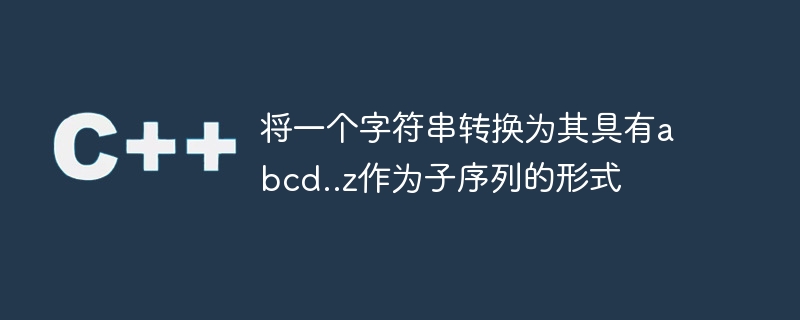
字符串转换(也称为字符串转换)是 C++ 中的一种操作,在整个过程执行后,将结果存储在输出数组中。在C++中,有一个名为“transform()”的函数,存在于C++环境的目录中,通过它我们可以将字符串转换为新的字符串。
有两种形式的转换函数−
一元运算
操作应用于输入数组的每个元素。
手术完成后,结果将存储在一个输出数组中。
二元操作
操作适用于特定数组的每个元素。
第一个输入元素和第二个相应的输入元素参与了操作。
输出数据将存储在一个输出数组中。
子序列字符串是由对输入字符串执行各种操作(例如:删除)生成的全新字符串。对于子序列字符串,操作发生时不会影响剩余的字符。
对于字符串转换,输入包含长度为n+1的操作字符串。原始字符属于a到z的系列。打印字符串的长度在这里被视为n,这里是一个输出字符串。
在本文中,我们将学习如何在C++环境中转换一个字符串,使其具有abcd….z作为一个子序列。
递归算法生成后续字符串
通过使用递归方法,下面是一个可能的算法用于一个后续字符串。这是特定的字符串,T是完成操作所需的时间。
步骤 1 - 计算出现次数。
步骤2 - 如果i = length(s)且j = length(T)。
第三步−然后返回1。
第4步 - 结束。
步骤5 - 如果i = length(S)。
步骤6 - 然后返回0。
第7步 - 结束。
步骤 8 − 计数 <-- 0。
步骤9 - 如果,j
步骤10 − Count<-- count + countOccurences(i+1,j+1).
第11步 - 结束。
第12步 - Count<-- count + countOccurences(i+1,j)。
第13步 - 返回计数。
第14步 - 结束。
后续数组的语法
'Here, we have two given sequences. X and Y.
Initialize a table with a dimension of X.length * Y.length
X.label1 = X
Y.label2 = Y
CS1[0][] = 0
CS2[][0] = 0
Start from CS[1][1]
Compare X[i] and Y[j]
If
X[i] = Y[j]
CS[i][j] = 1 + CS[i-1, j-1]
Point an arrow to CS[i][j]
Else
CS[i][j] = max(CS[i-1][j], CS[i][j-1])
Point an arrow to max(CS[i-1][j], CS[i][j-1])
这里我们创建了一个后续数组的基本工作语法。当有两个序列时,我们必须按照以下步骤来获取输出。
跟随的方法
方法1−使用C++转换字符串
通过使用C++对字符串进行一元操作的方法2
使用C++对字符串进行二进制操作的方法3
使用C++打印所有可能的后续字符串
使用C++将字符串转换为具有abcd….z作为子序列的方法5
使用 C++ 转换字符串
在这段C++代码中,我们创建了一个新的字符串,并从输入字符串中删除了所有的元音字母。在这些元音字母的位置上添加了#。
示例 1
'#include <bits/stdc++.h>
using namespace std;
string change_case(string r) {
int l = r.length();
for(int i = 0 ; i < l ; i++) {
if(r[i] >= \'a\' && r[i] <= \'z\')
r[i] = r[i] - 32;
else if(r[i] >= \'A\' && r[i] <= \'Z\')
r[i] = r[i] + 32;
}
return r;
}
string delete_vowels(string a) {
string temp = "";
int l = a.length();
for(int i = 0 ; i < l ; i++) {
if(a[i] != \'a\' && a[i] != \'e\' &&
a[i] != \'i\' && a[i] != \'o\' &&
a[i] != \'u\' && a[i] != \'A\' &&
a[i] != \'E\' && a[i] != \'O\' &&
a[i] != \'U\'&& a[i] != \'I\')
temp += a[i];
}
return temp;
}
string insert_hash(string a) {
string temp = "";
int l = a.length();
for(int i = 0 ; i < l ; i++) {
if((a[i] >= \'a\' && a[i] <= \'z\') ||
(a[i] >= \'A\' && a[i] <= \'Z\'))
temp = temp + \'#\' + a[i];
else
temp = temp + a[i];
}
return temp;
}
void transformSting(string a) {
string b = delete_vowels(a);
string c = change_case(b);
string d = insert_hash(c);
if(d=="")
cout<<"-1"<<endl;
else
cout << d<<endl;
}
int main() {
string a = "RudraDevDas!!";
string b = "aeiou";
transformSting(a);
transformSting(b);
return 0;
}
输出
'#r#D#R#d#V#d#S!!
-1
使用C++对字符串进行一元操作
在这段特定的代码中,我们展示了如何对输入数组进行一元操作。该函数接受一个指向单个输入的起始和结束位置的指针。并在输出数组的起始位置进行操作。
Example 2
的中文翻译为:示例2
'#include <iostream>
#include <algorithm>
using namespace std;
int op_increment (int x) {
x = x + 1;
return x;
}
int main () {
int n = 5;
int input_array[] = {7, 16, 10, 97, 2001};
int output_array[n];
std::cout << "Input array present here:";
for(int i=0; i<5; i++){
cout << \' \' << input_array[i];
}
cout << \'\n\';
transform (input_array, input_array+5, output_array, op_increment);
std::cout << "The output array now contains with:";
for(int i=0; i<5; i++){
cout << \' \' << output_array[i];
}
cout << \'\n\';
return 0;
}
输出
'Input array present here: 7 16 10 97 2001
The output array now contains with: 8 17 11 98 2002
使用C++对字符串进行二进制操作
在这段特定的代码中,我们展示了如何在输入数组上进行二进制操作。函数transform()在起始点和第一个输入数组之间添加了一个指针。请记住,二进制操作总是在两个输入数据集上进行。
Example 3
的中文翻译为:示例 3
'#include <iostream>
#include <algorithm>
#include <vector>
using namespace std;
int op_add (int i, int j) {
return i+j;
}
int main () {
int n = 5;
int arr1[] = {7, 16, 10, 2001, 1997};
int arr2[] = {1, 2, 3, 4, 5};
int output[n];
std::cout << "Input data in array1:";
for(int i=0; i<n; i++){
cout << \' \' << arr1[i];
}
cout << \'\n\';
std::cout << "Input data in array2:";
for(int i=0; i<n; i++){
cout << \' \' << arr2[i];
}
cout << \'\n\';
std::transform (arr1, arr1+n, arr2, output, op_add);
std::cout << "Output array is here now:";
for(int i=0; i<5; i++){
cout << \' \' << output[i];
}
cout << \'\n\';
return 0;
}
输出
'Input data in array1: 7 16 10 2001 1997
Input data in array2: 1 2 3 4 5
Output array is here now: 8 18 13 2005 2002
使用C++打印所有后续字符串
应用选择和不选择的概念来找出特定数组的所有子序列。在这个过程中,可能会删除一些字符而不改变元素的顺序。在这里,这个过程的时间复杂度是O(2^n),空间复杂度是O(n)。
示例 4
'#include <bits/stdc++.h>
using namespace std;
void printSubsequence(string input, string output) {
if (input.empty()) {
cout << output << endl;
return;
}
printSubsequence(input.substr(1), output + input[0]);
printSubsequence(input.substr(1), output);
}
int main() {
string output = "";
string input = "rudraabonikoaa";
printSubsequence(input, output);
return 0;
}
输出
'rudraabonikoaa
rudraabonikoa
rudraabonikoa
rudraaboniko
rudraabonikaa
rudraabonika
rudraabonika
rudraabonik
rudraabonioaa
rudraabonioa
rudraabonioa
rudraabonio
rudraaboniaa
rudraabonia
rudraabonia
将字符串转换为其具有abcd…z作为子序列
这是一种特定的过程,用于将字符串转换为具有abcd...z作为子序列的形式。
初始化字符。
如果长度小于26,则返回false。
迭代循环从0到s.size() - 1。
如果字符达到z,则跳出循环。
如果当前字符小于s或等于字符。
将当前字符的增量替换为1。
如果字符小于或等于 z,则返回 false。
否则,返回true。
在这个过程中,时间复杂度为O(n),辅助空间为O(1)。这里,n是特定字符串的长度。
Example 5
的中文翻译为:示例5
'#include <bits/stdc++.h>
using namespace std;
bool transformString(string& s) {
char ch = \'a\';
if (s.size() < 26)
return false;
for (int i = 0; i < s.size(); i++) {
if (int(ch) > int(\'z\'))
break;
if (s[i] <= ch) {
s[i] = ch;
ch = char(int(ch) + 1);
}
}
if (ch <= \'z\')
return false;
return true;
}
int main() {
string str = "aaaaaaaaaaaaaaaaaaaaaaaaaaa";
if (transformString(str))
cout << str << endl;
else
cout << "Not Possible" << endl;
return 0;
}
输出
'abcdefghijklmnopqrstuvwxyza
结论
在本文中,我们学习了使用C++环境进行字符串转换及其不同形式。通过遵循特定的算法和语法,我们检查和构建了一些不同的C++代码,并了解了如何转换字符串,使其具有abcd...z作为子序列。



